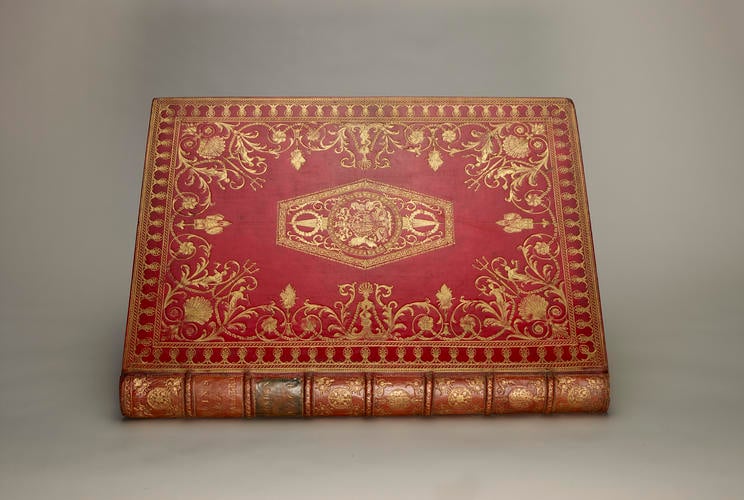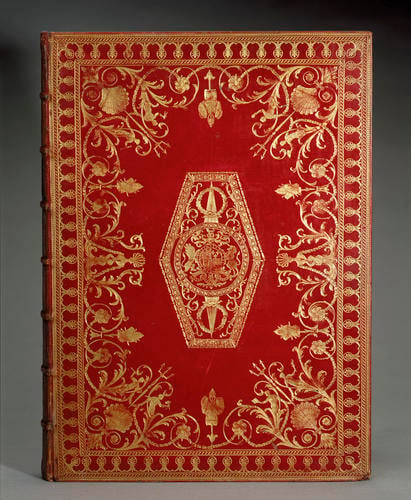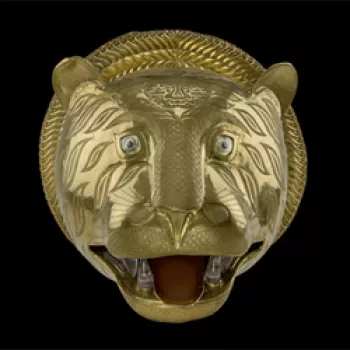Ruins of the palace of the Emperor Diocletian at Spalatro 1764
53.7 x 39.2 x 5.5 cm (book measurement (conservation)) | RCIN 1071086
-
Bound in red goatskin, gold tooled.
Robert Adam is today known as one of the foremost practitioners of the neo-classical style of architecture. The son of the architect, builder and entrepreneur William Adam, he undertook the Grand Tour (1754-8) after his university education, though with more constructive ambitions towards the antique than most of his contemporaries. He became acquainted with archaeologists and architects, and designed fantasy buildings based upon what he saw in Rome. The climax of his tour was Dalmatia, which he visited in 1757 in the company of the French architect Charles-Louis Clérisseau (1721-1820) and two other draughtsmen. Clérisseau’s speciality was in fantasy buildings or actual buildings set in imagined, romantic landscapes, and he was to provide the picturesque views and romanticised images of the palace at Spalato (formerly Spalatro; now Split) for Adam’s magnum opus. The publication of large folio volumes of illustrations of the antique was in its heyday, and offered a perfect opportunity for Adam to make his name and challenge his rivals with a magnificent production. Adam took seven years to produce his volume after the visit to Dalmatia, finally publishing it in 1764. The engravings were supplied by Francesco Bartolozzi among others and the publication may be seen as part of Adam’s single-minded ambition to establish himself as the leading architect in England as well as Scotland.
In his presentation copies of this magnificent book, Adam appears to have used a hierarchy of binding colour and ornamentation, appropriate to the importance of the recipients. Royal recipients, and institutions with royal patronage, received red goatskin bindings; friends and lesser patrons received mottled brown calf bindings; and it has been suggested (based on two surviving copies), that members of the Orders of the Garter or of the Thistle received, respectively, blue and green coloured bindings. The present binding is clearly one of the royal presentation copies, in red goatskin, with the Royal Arms in the central ornament, shaped like a Roman shield. The anthemion border, in neo-classical style, is common to all copies, but where this and other high-status copies really stand out is in the dentelle (lace-like) work, featuring a marvellous jumble of figures such as mermaids, trophies, tridents, rosettes and garlands. The style is part neo-classical, part rococo. The volume was dedicated to George III and at least two copies were presented to him: the present one, and an almost identical copy now in the British Library. The binder is not known.
Catalogue entry adapted from George III & Queen Charlotte: Patronage, Collecting and Court Taste, London, 2004.Provenance
Presented by the author to George III, 1764; George III (Windsor Library Catalogue, f. 66)
-
Creator(s)
Acquirer(s)
-
Measurements
53.7 x 39.2 x 5.5 cm (book measurement (conservation))
54.0 x 5.5 cm (book measurement (inventory))
Category
Other number(s)
ESTC : English Short Title Catalogue Citation Number – ESTC T46923Alternative title(s)
Ruins of the Palace of the Emperor Diocletian at Spalatro in Dalmatia / by R. Adam.











